Step 2: Applying the Policy Object
You can apply the Policy Object by using the Scope tab in the Properties dialog box for that Policy Object:
- On the Scope tab, click the Scope button to display the Active Roles Policy Scope window for the Policy Object you are managing.
- Click Add and select the domain, OU, or Managed Unit where you want to apply the policy.
You can also use the Remove button to remove items where you want the policy to no longer be applied.
- Click OK to close the Active Roles Policy Scope window.
- Click OK to close the Properties dialog box for the Policy Object.
For more information on how to apply a Policy Object, see Applying Policy Objects and Managing policy scope earlier in this chapter.
Group Membership Autoprovisioning policies help you automate adding or removing the specified objects (such as user objects) to or from the specified groups.
In case of cloud-only Azure objects, you can use the Group Membership Autoprovisioning policy to automatically assign (or unassign) Azure users and Azure guest users to (or from) the specified O365 group(s) in the same Azure tenant.
NOTE: Policy Object settings specific to Azure cloud-only objects (such as cloud-only Azure users, guest users, or contacts) are available only if your Active Roles deployment is licensed for managing cloud-only Azure objects. Contact One Identity support for more information.
Also, Policy Objects specific to Azure cloud-only objects will work correctly only if an Azure tenant is already configured in the AD of the organization, and Active Roles is already set as a consented Azure application for that Azure tenant. For more information on these settings, see Configuring a new Azure tenant and consenting Active Roles as an Azure application.
To set up a policy, select the type of objects you want to provision, select the affected group(s), and then configure the policy rules. Once set up, the policy adds (or removes) directory objects to (or from) the selected groups depending on whether the provisioned objects meet the specified rules.
To help you get started with configuring policy-based administration in your organization, Active Roles includes a set of built-in Policy Objects that offer provisioning and deprovisioning rules to the most typical administrative use cases. To find the built-in Policy Objects, navigate to the following node of the Active Roles MMC console:
Configuration > Policies > Administration > Builtin
NOTE: Active Roles does not automatically check for changes in directory objects, containers or groups specified for provisioning in the configured Policy Objects. This means that if any changes are made in any directory resources in use in a policy, you must update the impacted policies manually. For example, if a directory group used by a Group Membership AutoProvisioning Policy Group is deleted, the Policy Group must be updated manually to reflect the changes.
A Group Membership AutoProvisioning policy performs provisioning tasks such as adding or removing users from groups. A policy can be configured to define a list of groups and conditions so that a user account is automatically added to, or removed from, those groups depending on whether the properties of the user account meet the policy conditions.
Active Roles automatically checks users against conditions, and adds or removes users from specified groups based on the check results. Although the capabilities of this policy are similar to those provided by Dynamic Groups, a Group Membership AutoProvisioning policy gives the administrator extra flexibility and control over group memberships.
Whereas the Dynamic Groups feature delivers a rules-based mechanism for managing a group membership list as a whole, a Group Membership AutoProvisioning policy allows the administrator to define membership rules on a per-user basis. This policy automates the process of adding particular users to particular groups without affecting the other members of those groups.
To configure a Group Membership AutoProvisioning policy, select Group Membership AutoProvisioning on the Policy to Configure page in the New Provisioning Policy Object wizard or in the Add Provisioning Policy wizard. Then, click Next to display the Object Type Selection page.
Figure 62: Object type selection
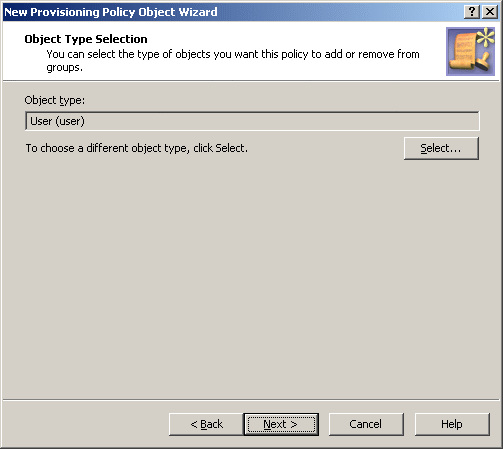
On this page, you can choose the type of objects you want the policy to add or remove from groups. By default, the object type is set to User. If you need to change this setting, click Select to display the Select Object Type dialog box.
Figure 63: Object types
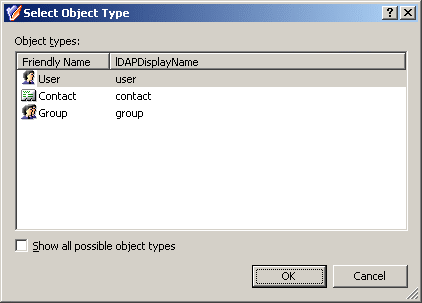
From the Object types list, select the type of objects you want the policy to control. Click OK.
On the Object Type Selection page, click Next to display the Policy Conditions page.
Figure 64: Policy conditions
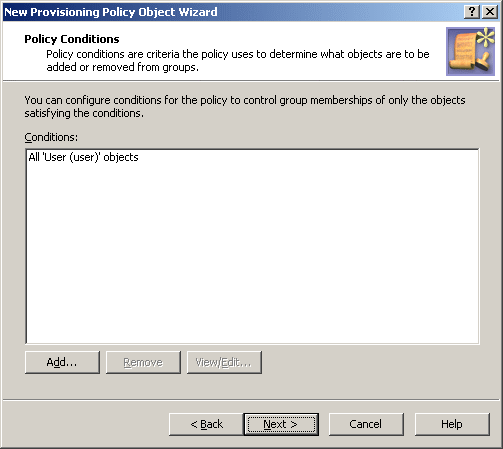
On this page, you can set up policy conditions—criteria the policy uses to determine what objects are to be added or removed from groups. If you specify no conditions, the policy affects any objects of the type you have selected on the previous page. Otherwise, it only affects the objects matching the conditions you specify using this page.
To configure a condition, click Add on the Policy Conditions page. This displays the Set Up Condition dialog box.
Figure 65: Set up condition
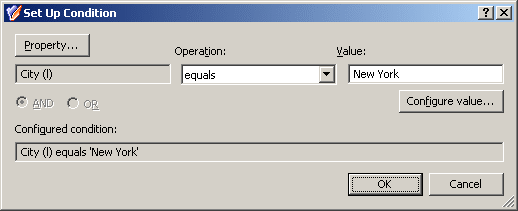
In this dialog, you can configure a condition in the same way as you do for a Property Generation and Validation policy. A condition includes an object property (for example, City or Department), a requirement (for example, equals or begins with), and a value. The term value has the same meaning as for a Property Generation and Validation policy.
First, click the Property button to display the Select Object Property dialog box where you can select the object property you want to include in the condition.
Next, from the Operation list, select the requirement you want to apply to the selected property.
Next, click the Configure value button to compose the value for which you want to apply the selected requirement. This displays the Configure Value dialog box, discussed earlier in this chapter (see How to configure a Property Generation and Validation policy). You can use that dialog box to set up a value in the same way as for a Property Generation and Validation Policy.
If you specify multiple conditions, you can combine them with a logical AND or OR operator by clicking the AND or OR option, respectively.
Finally, click OK to close the Set Up Condition dialog box.
After you complete the list on the Policy Conditions page, click Next to display the Policy Action page.
Figure 66: Policy action
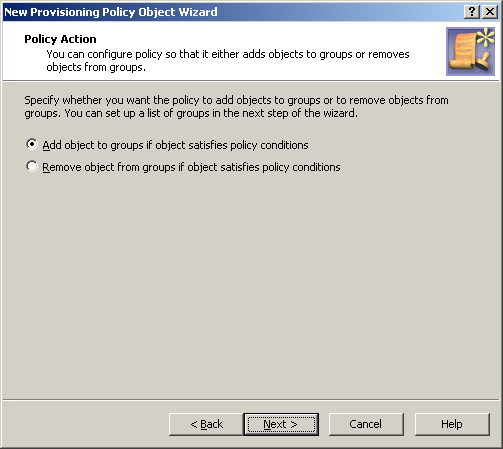
On this page, you can configure the policy to either add objects to groups or remove objects from groups. For example, if you select the option Add object to groups if object satisfies policy conditions, the policy populates groups with the objects that match the conditions you set up in the previous step. Click Next to specify the groups you want the policy to populate. This displays the Group Selection page.
Figure 67: Group selection

On the Group Selection page, you can set up a list of groups you want the policy to control. Depending on the option you select in the previous step, the policy either adds or removes objects from each of the groups you specify on this page. You can manage the list by using the Add and Remove buttons. Clicking Add displays the Select Objects dialog box to select and add groups to the list. Clicking Remove deletes the selected entries from the list.
Once you have set up the list of groups, click Next and follow the instructions in the wizard to create the Policy Object.






